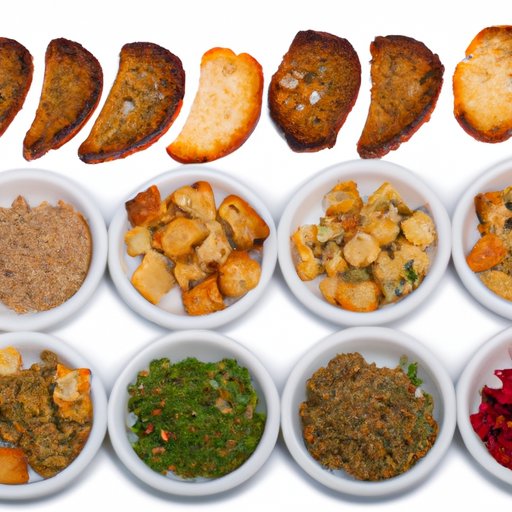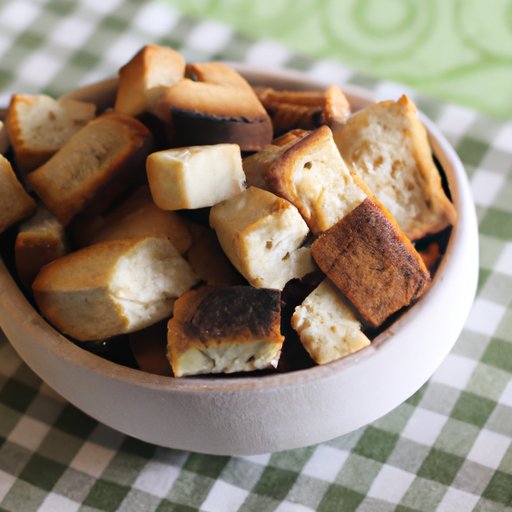I. Introduction
Croutons are a delicious, versatile topping that can add flavor and crunch to a variety of dishes. While store-bought croutons are convenient, nothing compares to the flavor and freshness of homemade ones. Making croutons at home not only tastes better, but it also reduces food waste and allows for more customization based on personal taste preferences and dietary needs.
II. Step-by-Step Guide to Making Homemade Croutons
Before diving into the recipe, gather the ingredients and tools you’ll need. For basic croutons, all you need is bread, oil or butter, salt, and any seasoning of your choice. You’ll also need a baking sheet and an oven.
Preheat your oven to 375°F (190°C). Cut your bread into small cubes and place them in a bowl. Drizzle with oil or melted butter and toss until every piece is coated. Add salt and any other seasoning of your choice and give it another toss.
Spread the croutons out on a baking sheet in a single layer. Bake for 10-15 minutes or until golden brown, flipping halfway through. Allow them to cool before serving.
For extra crispy croutons, use stale bread or let fresh bread sit out overnight to dry out. The drier the bread, the crispier the croutons will be. You can also use a combination of oil and butter for added flavor.
III. The Science Behind Making Perfectly Crispy Croutons
The key to making perfectly crispy croutons is understanding the role of oil, seasoning, and heat. Oil helps to create a crispy texture by coating the bread cubes and preventing them from becoming soggy. You can use any oil you prefer, such as olive oil, vegetable oil, or even bacon grease.
Seasoning not only adds flavor but also helps the croutons to brown evenly and crisp up. Salt is a must-have, but you can also experiment with different herbs and spices like garlic powder, paprika, or even curry powder.
Finally, the oven temperature and baking time can make or break your croutons. 375°F (190°C) is the sweet spot for most bread types, but if you’re using a denser bread like rye, you may need to increase the temperature to get them crispy. Be sure to keep an eye on them and flip halfway through to ensure even browning.

IV. Ten Delicious Seasoning Combinations for Homemade Croutons
While simple salt and pepper are sure to do the trick, there are plenty of seasoning blends to take your croutons to the next level:
- Garlic and Herb – A classic combination that pairs well with any soup or salad.
- Spicy Buffalo – Toss your croutons in buffalo sauce and serve with a side of blue cheese dressing for a spicy kick.
- Taco Salad – Add taco seasoning to your croutons for a south-of-the-border twist.
- Cheesy – Toss your croutons with grated Parmesan cheese for a cheesy and crispy topping.
- Balsamic – Drizzle balsamic vinegar over your croutons before baking for a tangy addition to any salad.
- Honey Mustard – Toss your croutons in honey mustard dressing before baking for a sweet and savory flavor.
- Cinnamon Sugar – A perfect topping for fall salads and soups, cinnamon sugar croutons also make a great snack on their own.
- Rosemary and Olive Oil – A fragrant and savory seasoning that pairs well with roasted vegetables.
- Italian Tomato and Basil – Add dried tomatoes and basil to your croutons for an Italian-inspired twist.
- Lemon and Thyme – Toss your croutons in fresh lemon juice and thyme for a citrusy and herbaceous flavor.
V. How to Use Leftover Bread to Make Croutons and Reduce Food Waste
One of the benefits of making homemade croutons is that they’re a great way to use up stale or leftover bread that might otherwise go to waste. Sourdough, French, and Italian bread are all great choices for croutons.
To prep the bread, cut it into small cubes and follow the same recipe as above. If the bread is especially dry, you can bump up the oil or butter content slightly to prevent them from getting too crispy. Leftover croutons can be stored in an airtight container for up to a week.
VI. Healthier Alternatives to Traditional Croutons
If you’re looking for a healthier version of croutons, there are a few options. Whole wheat or multi-grain bread can be used in place of white bread for added fiber and nutrients. Instead of frying, try air frying or toasting the croutons for a lighter, crunchier texture.
You can also reduce the salt content by using less salt or omitting it altogether and relying on seasoning blends instead. Consider using lower-calorie oils like grapeseed or coconut oil.
VII. Using Croutons as a Garnish or Snack
Croutons are a versatile and tasty topping that can elevate a variety of dishes:
- Add croutons to salads for extra crunch and flavor.
- Sprinkle croutons on top of soups, like tomato or butternut squash, for a hearty crunch.
- Use croutons instead of breadcrumbs in stuffed mushrooms or meatballs for added texture.
- Add croutons to a charcuterie board for a fun and unexpected addition.
Croutons can also be enjoyed on their own as a delicious snack. Try dipping them in hummus or a creamy dip for a crunchy treat any time of day.
VIII. The History of Croutons and Their Origins in French Cuisine
The word “crouton” comes from the French word “croûte,” meaning “crust.” Croutons were originally used to add texture to soups and stews in 17th century France. They were made by frying off stale bread in butter or oil until crispy.
Since then, croutons have become ubiquitous in Western cuisine. They can be found in everything from Caesar salads to French onion soup. Knowing the history of croutons can inspire you to incorporate them into your cooking in new and creative ways.
IX. Conclusion
Making homemade croutons is easy, delicious, and can add a special touch to any dish. Use stale bread, get creative with seasoning, and experiment with healthier alternatives for a personalized take on this classic topping.
Whether you’re adding crunch to a salad, soup, or simply snacking on them on their own, croutons are the perfect pairing for any meal. So next time you’re making dinner or hosting a party, consider making your own croutons for a tasty and budget-friendly addition to any dish.
